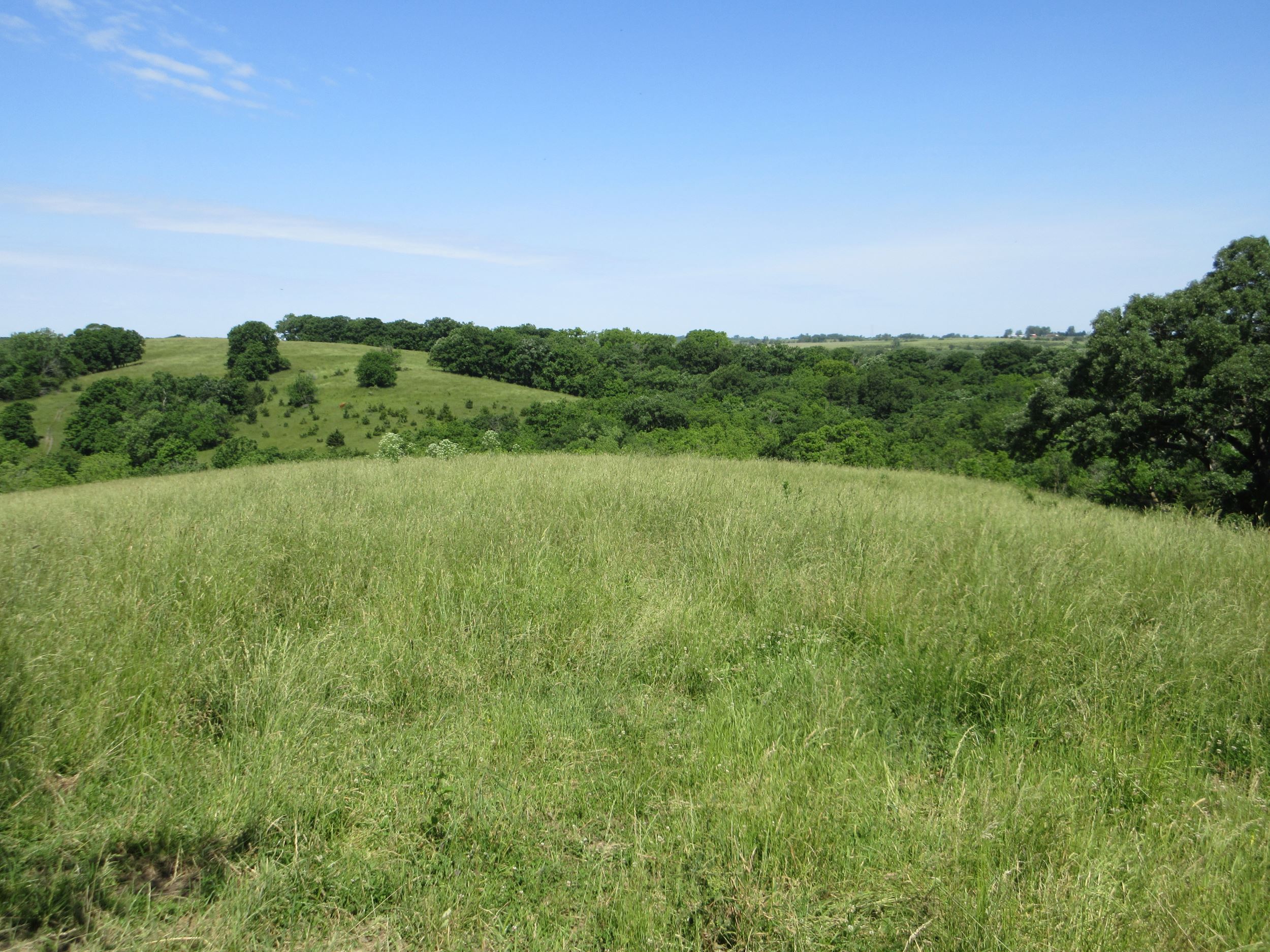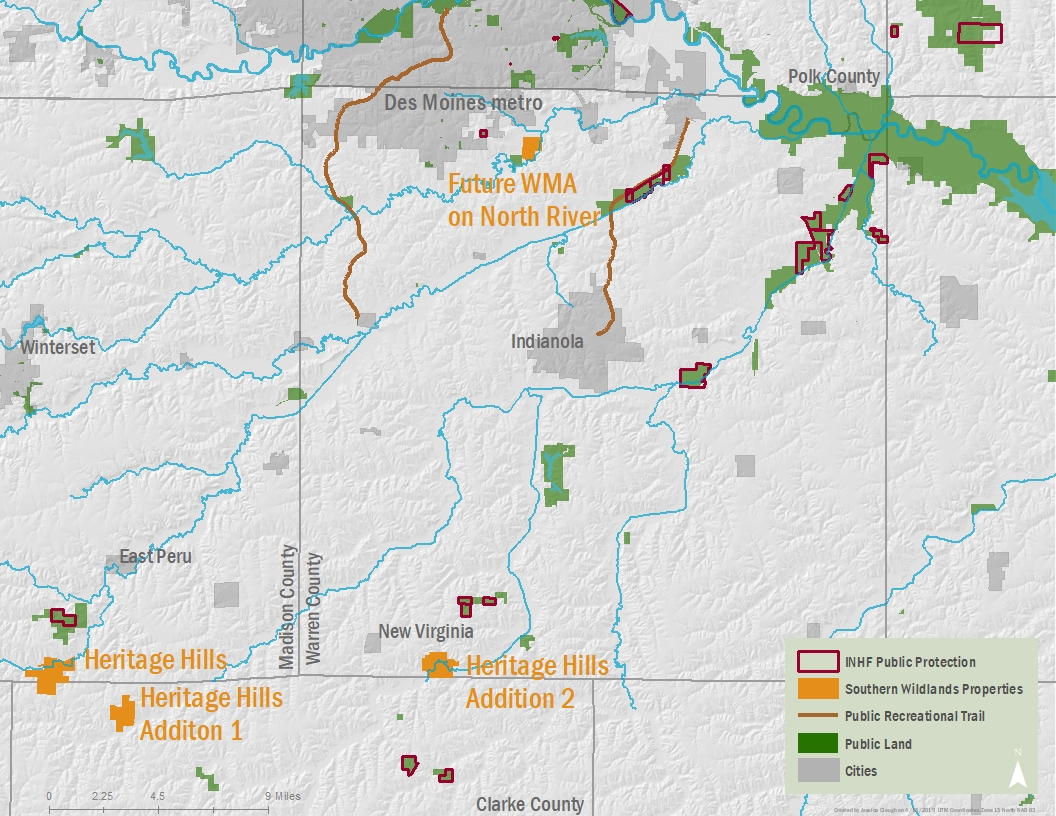Connecting Southern Wildlands
By Rowan McMullen Cheng on April 23, 2019 in Blog

As more Iowans are flocking to urban and suburban centers, the need for public land to explore and escape around these areas is ever increasing. Last fall, Iowa Natural Heritage Foundation, Pheasants Forever, Quail Forever and the Iowa DNR started a collaboration to provide more wildlife habitat and local greenspace to central Iowa hunters and outdoor enthusiasts.
Three new land protection projects will protect wildlife areas within an hour of the Des Moines metro area and increase public access to the outdoors. The new properties will be owned and managed by the Iowa DNR.
“All three of these areas have a little bit of everything for individuals to enjoy,” said Heath Van Waus, wildlife technician for the Iowa DNR.
When combined with the Heritage Hills Wildlife Management Area, a 1,021-acre area protected by INHF in 2016, the four properties make up the “Southern Wildlands” — and will total over 2,600 acres of wild land and wildlife habitat for central and southern Iowa.
River protection close to home
Only two miles south of Des Moines city limits, the 374-acre future wildlife management
area lies along the North River, a tributary of Lake Red Rock. Historically prone to flooding, permanent protection of the area provides water quality benefits to the North River floodplain and a new recreation area for central Iowa residents.
The previous landowners enrolled the land in the Conservation Reserve Program and planted it to native prairie before protecting it through INHF. The area will also provide critical habitat for creatures that require more space for breeding and foraging.

The four properties that make up the Southern Wildlands Complex (highlighted in orange) encompass over 2,600 acres of habitat and recreation area in southern and central Iowa. Large complexes of land are important for game and threatened species that need wide tracts of habitat for nesting and feeding. The three properties offer a mix of landscapes, from remnant prairie, restored grassland, and woodland to floodpain habitat. The properties will eventually be transferred to the Iowa DNR for public use.
Wide, open spaces
Just south of the Clarke and Madison county line, the nearly 600-acre Heritage Hills Addition 1 serves as a haven for wildlife, offering diverse habitat that includes woodland, grasslands, a pond and remnant prairies. Breathtaking views of the South River valley, a major tributary of the Des Moines River, are served on the tallgrass hilltops.
Both the Clanton Creek Recreation Area and Heritage Hills west of the addition create large, unbroken tracts of protected land for species of great conservation need as determined by the Iowa Wildlife Action Plan, like Henslow’s sparrow, Bobolinks and Eastern meadowlarks. The addition will contribute to that goal.
“Diversity is the main goal the Iowa DNR strives for on all our public lands,” Van Waus said. “This large addition of grassland will give us the opportunity to implement grassland management tools like prescribed fire, grazing and mechanical removal of invasive woody trees. The use of these tools will increase the diversity of the grasslands and the species that depend on it.”
With a methodical grid pattern to Iowa’s roadways, it’s rare to be more than a half-mile from a road anywhere in the state. In the few places not intersected by this grid, these larger pieces of land are uniquely suitable for a particular species that require unbroken, larger landscapes. The large land size increases wildlife ranges and reduces ecosystem fragmentation.
“Most of Iowa’s habitat is very fragmented,” Van Waus said. “It’s amazing to see these large parcels of land harboring so many species of wildlife, and it’s my goal to enhance these areas for the public to use and enjoy.”
Water quality protection at the forefront
Two miles of Squaw Creek run through the 700+ acres of the second addition to Heritage Hills Wildlife Management Area. With the restoration of nearly 200 of those acres, the Iowa DNR hopes to reduce stream bank soil erosion along Squaw Creek, helping to improve and increase Squaw Creek’s aquatic life both in the area and further downstream.
Because of its size, Addition 2 is comprised of a multitude of different habitats. From river bottomlands to scattered oak timber and cedar thickets, Addition 2 provides sanctuary for an extensive variety of wildlife. Small mammals, reptiles, migratory birds and even game birds will have access to stable, quality habitat.
All together, the Southern Wildlands are expansive, secluded and wild, and will continue to develop diverse and rich ecosystems. With wildlife protection and recreation both in mind, these sizeable areas reflect a larger conservation vision for Iowa.
“This large complex of land provides the opportunity to have quality resources for multiple species so close to the Des Moines metro while protecting water quality,” said Ross Baxter, INHF land projects director. “What this complex offers is a wild experience for future generations of recreationists and hunters.”
Gifts to the Southern Wildlands complex will support restoration on these sites and speed up the process of opening them to the public. Contact Abby Hade Terpstra at aterpstra@inhf.org or 515-288-1846 to learn more or pledge support.